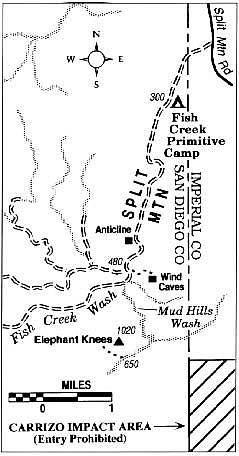 Facebook
Facebook
 X
X
 Instagram
Instagram
 TikTok
TikTok
 Youtube
Youtube
This five-mile walk, in the low-lying, desolate, dry Carrizo Badlands of Anza-Borrego Desert State Park, takes you to fossil shell "reefs" so dense with fossils that fossilized shells and shell fragments outweigh the sandy matrix in which they are embedded.
A high-clearance automobile (or mountain bike) is recommended for reaching the starting point; otherwise you may be obliged to walk an additional four to five miles round trip. Drive east on Highway 78 to the desert town of Ocotillo Wells, then go eight miles south on the paved Split Mountain Road to the dirt-road turnoff for Fish Creek Primitive Camp. Short of the turnoff, signs announcing fees for using the park ($5 per day, $10 for three days) call your attention to an automated machine by the roadside that will accept your cash or credit card.
The dirt road follows Fish Creek Wash, which is typically dry and firm in late fall and winter but possibly slippery with mud following a major storm. Ahead looms Split Mountain, with cliff-like walls that occasionally shed rock debris onto the dirt road below. Drive on, passing (after a couple of inspiring miles) a dramatic thumbprint-shaped anticline and an interpretive plaque describing it.
Beyond the anticline, the walls of Split Mountain part and the sandy wash becomes wider. Park here on hard-packed sand. On the left (east) slope, you'll spot a narrow trail ascending to the "wind caves," a worthy side trip. These Swiss-cheese outcrops of sandstone were sculpted in part by the abrasive action of wind-blown sand particles.
For the hike to fossil reefs, head south in the main Fish Creek Wash for about 0.3 mile to where Mud Hills Wash comes in from the left (south). Walk south past the vehicle-closure signs and make your way along the smooth bed of the wash. If the wash bottom is moist from recent rain, you'll accumulate an inch or two of mud on your shoes, but that's part of the fun.
On the right is a spectacular undulating landscape of mud hills, glistening with flakes of gypsum. The gypsum is a type of salt (calcium sulfate) that remained when water evaporated from a briny inland sea millions of years ago. Above the mud hills rises a flat-topped butte with erosional features known as elephant knees along its north flank.
About 1.5 miles up meandering Mud Hills Wash, there's a major split. Take the right (southwest) fork, and swing around to the south side of the elephant knees butte. There you'll find, scattered along the wash and imbedded within the butte, the fossilized remains of oysters and pectens (scallops) that thrived in a northern extension of today's Gulf of California several millions of years ago. Keep in mind that no collecting of fossils is allowed in the state park.


This five-mile walk, in the low-lying, desolate, dry Carrizo Badlands of Anza-Borrego Desert State Park, takes you to fossil shell "reefs" so dense with fossils that fossilized shells and shell fragments outweigh the sandy matrix in which they are embedded.
A high-clearance automobile (or mountain bike) is recommended for reaching the starting point; otherwise you may be obliged to walk an additional four to five miles round trip. Drive east on Highway 78 to the desert town of Ocotillo Wells, then go eight miles south on the paved Split Mountain Road to the dirt-road turnoff for Fish Creek Primitive Camp. Short of the turnoff, signs announcing fees for using the park ($5 per day, $10 for three days) call your attention to an automated machine by the roadside that will accept your cash or credit card.
The dirt road follows Fish Creek Wash, which is typically dry and firm in late fall and winter but possibly slippery with mud following a major storm. Ahead looms Split Mountain, with cliff-like walls that occasionally shed rock debris onto the dirt road below. Drive on, passing (after a couple of inspiring miles) a dramatic thumbprint-shaped anticline and an interpretive plaque describing it.
Beyond the anticline, the walls of Split Mountain part and the sandy wash becomes wider. Park here on hard-packed sand. On the left (east) slope, you'll spot a narrow trail ascending to the "wind caves," a worthy side trip. These Swiss-cheese outcrops of sandstone were sculpted in part by the abrasive action of wind-blown sand particles.
For the hike to fossil reefs, head south in the main Fish Creek Wash for about 0.3 mile to where Mud Hills Wash comes in from the left (south). Walk south past the vehicle-closure signs and make your way along the smooth bed of the wash. If the wash bottom is moist from recent rain, you'll accumulate an inch or two of mud on your shoes, but that's part of the fun.
On the right is a spectacular undulating landscape of mud hills, glistening with flakes of gypsum. The gypsum is a type of salt (calcium sulfate) that remained when water evaporated from a briny inland sea millions of years ago. Above the mud hills rises a flat-topped butte with erosional features known as elephant knees along its north flank.
About 1.5 miles up meandering Mud Hills Wash, there's a major split. Take the right (southwest) fork, and swing around to the south side of the elephant knees butte. There you'll find, scattered along the wash and imbedded within the butte, the fossilized remains of oysters and pectens (scallops) that thrived in a northern extension of today's Gulf of California several millions of years ago. Keep in mind that no collecting of fossils is allowed in the state park.
